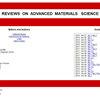Exploring the viability of AI-aided genetic algorithms in estimating the crack repair rate of self-healing concrete
IF 3.6
4区 材料科学
Q2 MATERIALS SCIENCE, MULTIDISCIPLINARY
引用次数: 0
Abstract
As a potential replacement for traditional concrete, which has cracking and poor durability issues, self-healing concrete (SHC) has been the research subject. However, conducting lab trials can be expensive and time-consuming. Therefore, machine learning (ML)-based predictions can aid improved formulations of self-healing concrete. The aim of this work is to develop ML models that could analyze and forecast the rate of healing of the cracked area (CrA) of bacteria- and fiber-containing SHC. These models were constructed using gene expression programming (GEP) and multi-expression programming (MEP) tools. The discrepancy between expected and desired results, statistical tests, Taylor’s diagram, and探索人工智能辅助遗传算法在估算自愈合混凝土裂缝修复率方面的可行性
传统混凝土存在开裂和耐久性差等问题,作为传统混凝土的潜在替代品,自愈合混凝土(SHC)一直是研究课题。然而,进行实验室试验既昂贵又耗时。因此,基于机器学习(ML)的预测可以帮助改进自愈合混凝土的配方。这项工作的目的是开发 ML 模型,用于分析和预测含细菌和纤维的 SHC 裂缝区域(CrA)的愈合率。这些模型是利用基因表达编程(GEP)和多重表达编程(MEP)工具构建的。预期结果与理想结果之间的差异、统计测试、泰勒图和 R 2 值是用于评估所建模型的附加指标。采用了 SHapley Additive exPlanations(SHAP)方法来评估哪些输入属性具有高度相关性。R 2 = 0.93、MAE = 0.047、MAPE = 12.60%、RMSE = 0.062,GEP 的预测结果比 MEP(R 2 = 0.93、MAE = 0.033、MAPE = 9.60%、RMSE = 0.044)要差一些。SHAP研究表明,细菌与SHC的CrA有间接(负)关系,而纤维与SHC的CrA有直接(正)关系。SHAP 研究可能有助于研究人员和公司确定 SHC 所需的每种原材料的用量。因此,MEP 和 GEP 模型可用于生成和测试基于细菌和聚合纤维的 SHC 成分。
本文章由计算机程序翻译,如有差异,请以英文原文为准。
求助全文
约1分钟内获得全文
求助全文
来源期刊

Reviews on Advanced Materials Science
工程技术-材料科学:综合
CiteScore
5.10
自引率
11.10%
发文量
43
审稿时长
3.5 months
期刊介绍:
Reviews on Advanced Materials Science is a fully peer-reviewed, open access, electronic journal that publishes significant, original and relevant works in the area of theoretical and experimental studies of advanced materials. The journal provides the readers with free, instant, and permanent access to all content worldwide; and the authors with extensive promotion of published articles, long-time preservation, language-correction services, no space constraints and immediate publication.
Reviews on Advanced Materials Science is listed inter alia by Clarivate Analytics (formerly Thomson Reuters) - Current Contents/Physical, Chemical, and Earth Sciences (CC/PC&ES), JCR and SCIE. Our standard policy requires each paper to be reviewed by at least two Referees and the peer-review process is single-blind.
 求助内容:
求助内容: 应助结果提醒方式:
应助结果提醒方式:


